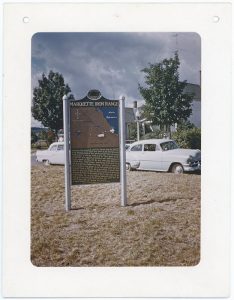The 1844 Discovery That Built Michigan’s Mining Legacy
On September 19, 1844, William Austin Burt and his surveying crew were trekking through the rugged Upper Peninsula wilderness when their compasses began acting strangely. The needles wavered and swung off course and not because of supernatural forces. But because they were standing atop one of the richest deposits of iron ore in North America: the Marquette Iron Range.
The following year, the Jackson Mining Company opened the Jackson Mine, and with it, the foundation for the city of Negaunee, Michigan. Before long, Ishpeming followed. While the California Gold Rush of 1848 pulled dreamers westward in search of $1 billion in gold, Michigan’s iron industry would quietly outshine it. The iron industry produced more than $48 billion worth of iron over its lifetime.
The Marquette Iron Range, also called the Negaunee Iron Formation by geologists, is a 33-mile-long, 3–6-mile-wide deposit of middle Precambrian rock, rich in magnetite and hematite chert. These natural ore deposits are tucked into synclines and pressed against mafic dikes. Mining began in earnest in 1847, first in open pits and later underground by the 1880s.
Striking Iron
Things really took off in 1855 with the opening of the Soo Canal. This allowed iron ore to be shipped by freighter from the port of Marquette to the hungry steel mills of the lower Great Lakes. Cleveland investors, especially the Cleveland-Cliffs Iron Company, played a big role in expanding operations. They eventually dominated the region by the 1890s.
By the mid-20th century, beneficiation — the process of concentrating ore into pellets — became the dominant production method. This process accounted for 73% of output by 1965. The Marquette Range was a workhorse of American industry. It produced iron ore continuously for more than 160 years. While the Empire Mine closed in 2016, the Tilden Mine continues shipping ore via the Lake Superior and Ishpeming Railroad to Marquette.
Today, the Marquette Iron Range is not just an industrial powerhouse of the past — it’s a celebrated chapter in Michigan history. Designated a Michigan Historic Site in 1957, the area’s mining heritage lives on in the area. You can visit the Cliffs Shaft Mine Museum or the Michigan Iron Industry Museum. The Iron Ore Heritage Trail is a 47-mile path connecting Republic to Marquette. Visitors can explore the very ground that once set a compass spinning.
From a single fateful day in 1844 to over a century of industrial might, the Marquette Iron Range remains a testament to how a simple surveyor’s reading changed the economic destiny of Michigan. It quite literally, pointed the way to iron’s golden age.
Historical Marker
Marquette Iron Range

Located at the City Park along US-41, Negaunee – Lat: 46.51251100/Long: -87.60227600
The first of the immensely rich Lake Superior iron ore deposits to be discovered and mined were those of the Marquette Iron Range. In 1844 William A. Burt and his surveying party discovered outcroppings of iron ore south of Teal Lake. This area soon became the first and has remained the chief center of the range’s mining.
In 1847 real production was underway at the Jackson Mine. Operations at the early mines were confined to ores at or close to the surface. Underground mining began after the Civil War when shafts were sunk. A forge built on the Carp River produced iron blooms in 1848. The pioneer furnace at Negaunee, built in 1857-58, was the first actual blast furnace. Most ore has been shipped out to be smelted. When the Iron Mountain Railroad was built in 1857 ore could be moved easily to Marquette. Here at the pocket docks, the first of which was built in 1857, the ore was loaded aboard ships and carried through the Soo Canal to the growing industrial centers in the East. Copper, gold, silver, and lead have been mined here but in small amounts only, leaving iron supreme.


